Comprehensive Critique: Research Paper on Evidence-Based Healthcare
VerifiedAdded on 2020/02/05
|8
|1972
|154
Report
AI Summary
This report provides a comprehensive critique of a research paper focused on evidence-based practice in healthcare. The critique examines the research questions, study design (descriptive research), and sampling methodology (stratified random sampling), assessing their strengths and weaknesses. It evaluates the data analysis techniques, particularly the use of SPSS and the chi-square test, while also discussing the ethical considerations followed by the study, such as confidentiality and informed consent. The report highlights the significance of the study in providing insights into the perceptions, skills, and activities of healthcare professionals regarding evidence-based practice, and the influence of EBP on patient care. The analysis also points out limitations, such as the lack of recent secondary data. The critique emphasizes the importance of EBP in enhancing the quality of care and the need for continuous evaluation and improvement in healthcare practices.
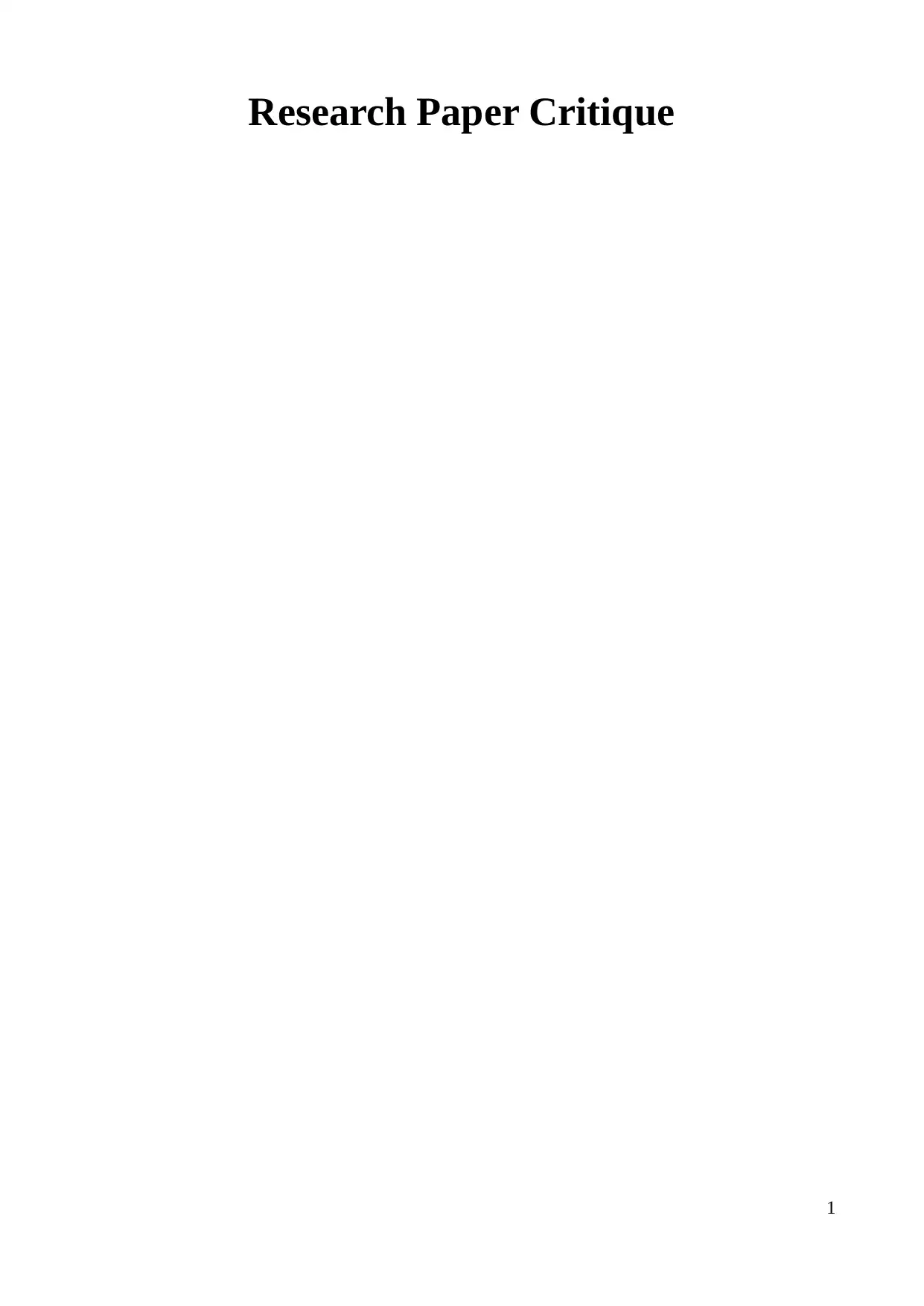
Research Paper Critique
1
1
Paraphrase This Document
Need a fresh take? Get an instant paraphrase of this document with our AI Paraphraser
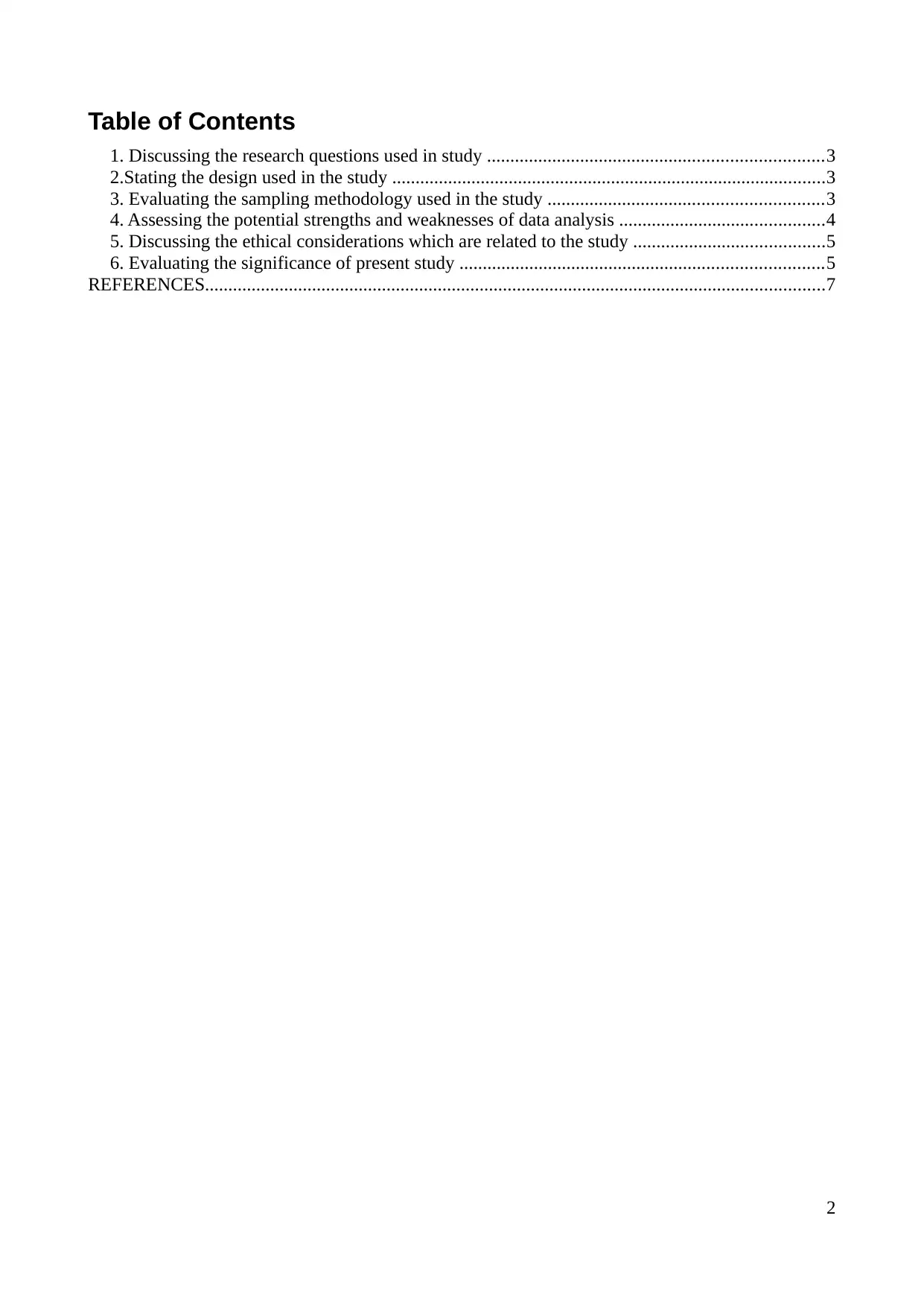
Table of Contents
1. Discussing the research questions used in study ........................................................................3
2.Stating the design used in the study .............................................................................................3
3. Evaluating the sampling methodology used in the study ...........................................................3
4. Assessing the potential strengths and weaknesses of data analysis ............................................4
5. Discussing the ethical considerations which are related to the study .........................................5
6. Evaluating the significance of present study ..............................................................................5
REFERENCES.....................................................................................................................................7
2
1. Discussing the research questions used in study ........................................................................3
2.Stating the design used in the study .............................................................................................3
3. Evaluating the sampling methodology used in the study ...........................................................3
4. Assessing the potential strengths and weaknesses of data analysis ............................................4
5. Discussing the ethical considerations which are related to the study .........................................5
6. Evaluating the significance of present study ..............................................................................5
REFERENCES.....................................................................................................................................7
2
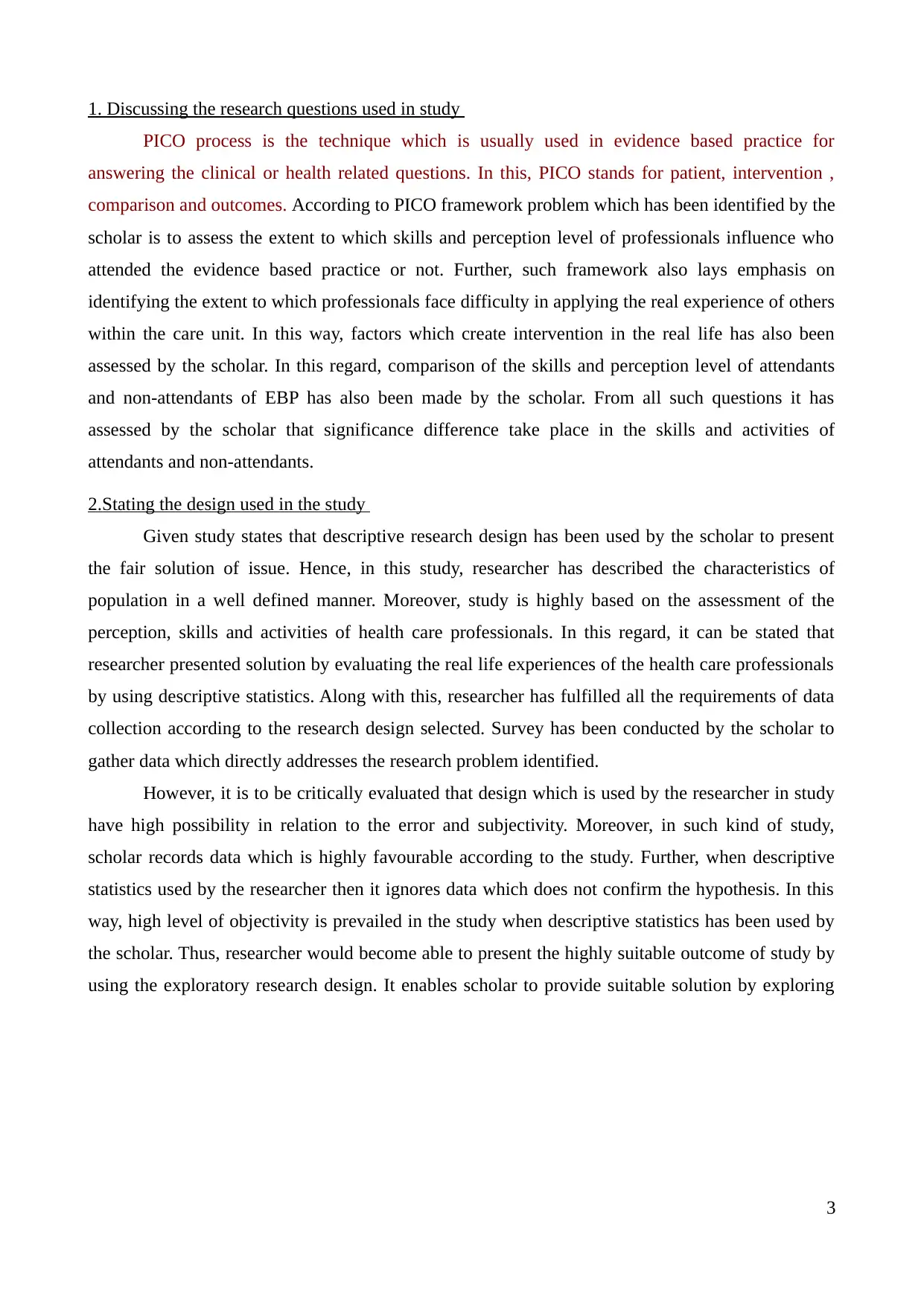
1. Discussing the research questions used in study
PICO process is the technique which is usually used in evidence based practice for
answering the clinical or health related questions. In this, PICO stands for patient, intervention ,
comparison and outcomes. According to PICO framework problem which has been identified by the
scholar is to assess the extent to which skills and perception level of professionals influence who
attended the evidence based practice or not. Further, such framework also lays emphasis on
identifying the extent to which professionals face difficulty in applying the real experience of others
within the care unit. In this way, factors which create intervention in the real life has also been
assessed by the scholar. In this regard, comparison of the skills and perception level of attendants
and non-attendants of EBP has also been made by the scholar. From all such questions it has
assessed by the scholar that significance difference take place in the skills and activities of
attendants and non-attendants.
2.Stating the design used in the study
Given study states that descriptive research design has been used by the scholar to present
the fair solution of issue. Hence, in this study, researcher has described the characteristics of
population in a well defined manner. Moreover, study is highly based on the assessment of the
perception, skills and activities of health care professionals. In this regard, it can be stated that
researcher presented solution by evaluating the real life experiences of the health care professionals
by using descriptive statistics. Along with this, researcher has fulfilled all the requirements of data
collection according to the research design selected. Survey has been conducted by the scholar to
gather data which directly addresses the research problem identified.
However, it is to be critically evaluated that design which is used by the researcher in study
have high possibility in relation to the error and subjectivity. Moreover, in such kind of study,
scholar records data which is highly favourable according to the study. Further, when descriptive
statistics used by the researcher then it ignores data which does not confirm the hypothesis. In this
way, high level of objectivity is prevailed in the study when descriptive statistics has been used by
the scholar. Thus, researcher would become able to present the highly suitable outcome of study by
using the exploratory research design. It enables scholar to provide suitable solution by exploring
3
PICO process is the technique which is usually used in evidence based practice for
answering the clinical or health related questions. In this, PICO stands for patient, intervention ,
comparison and outcomes. According to PICO framework problem which has been identified by the
scholar is to assess the extent to which skills and perception level of professionals influence who
attended the evidence based practice or not. Further, such framework also lays emphasis on
identifying the extent to which professionals face difficulty in applying the real experience of others
within the care unit. In this way, factors which create intervention in the real life has also been
assessed by the scholar. In this regard, comparison of the skills and perception level of attendants
and non-attendants of EBP has also been made by the scholar. From all such questions it has
assessed by the scholar that significance difference take place in the skills and activities of
attendants and non-attendants.
2.Stating the design used in the study
Given study states that descriptive research design has been used by the scholar to present
the fair solution of issue. Hence, in this study, researcher has described the characteristics of
population in a well defined manner. Moreover, study is highly based on the assessment of the
perception, skills and activities of health care professionals. In this regard, it can be stated that
researcher presented solution by evaluating the real life experiences of the health care professionals
by using descriptive statistics. Along with this, researcher has fulfilled all the requirements of data
collection according to the research design selected. Survey has been conducted by the scholar to
gather data which directly addresses the research problem identified.
However, it is to be critically evaluated that design which is used by the researcher in study
have high possibility in relation to the error and subjectivity. Moreover, in such kind of study,
scholar records data which is highly favourable according to the study. Further, when descriptive
statistics used by the researcher then it ignores data which does not confirm the hypothesis. In this
way, high level of objectivity is prevailed in the study when descriptive statistics has been used by
the scholar. Thus, researcher would become able to present the highly suitable outcome of study by
using the exploratory research design. It enables scholar to provide suitable solution by exploring
3
⊘ This is a preview!⊘
Do you want full access?
Subscribe today to unlock all pages.

Trusted by 1+ million students worldwide
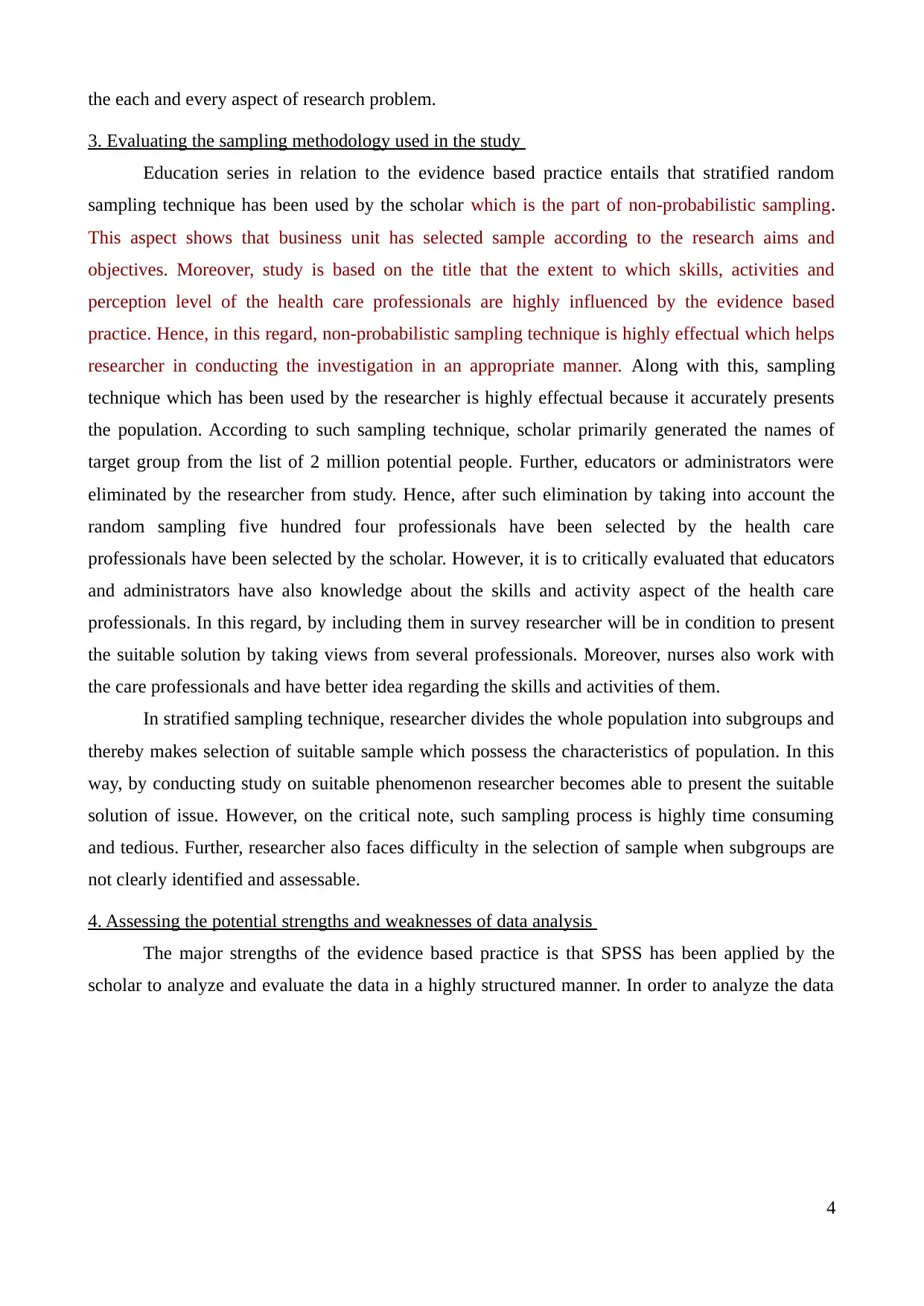
the each and every aspect of research problem.
3. Evaluating the sampling methodology used in the study
Education series in relation to the evidence based practice entails that stratified random
sampling technique has been used by the scholar which is the part of non-probabilistic sampling.
This aspect shows that business unit has selected sample according to the research aims and
objectives. Moreover, study is based on the title that the extent to which skills, activities and
perception level of the health care professionals are highly influenced by the evidence based
practice. Hence, in this regard, non-probabilistic sampling technique is highly effectual which helps
researcher in conducting the investigation in an appropriate manner. Along with this, sampling
technique which has been used by the researcher is highly effectual because it accurately presents
the population. According to such sampling technique, scholar primarily generated the names of
target group from the list of 2 million potential people. Further, educators or administrators were
eliminated by the researcher from study. Hence, after such elimination by taking into account the
random sampling five hundred four professionals have been selected by the health care
professionals have been selected by the scholar. However, it is to critically evaluated that educators
and administrators have also knowledge about the skills and activity aspect of the health care
professionals. In this regard, by including them in survey researcher will be in condition to present
the suitable solution by taking views from several professionals. Moreover, nurses also work with
the care professionals and have better idea regarding the skills and activities of them.
In stratified sampling technique, researcher divides the whole population into subgroups and
thereby makes selection of suitable sample which possess the characteristics of population. In this
way, by conducting study on suitable phenomenon researcher becomes able to present the suitable
solution of issue. However, on the critical note, such sampling process is highly time consuming
and tedious. Further, researcher also faces difficulty in the selection of sample when subgroups are
not clearly identified and assessable.
4. Assessing the potential strengths and weaknesses of data analysis
The major strengths of the evidence based practice is that SPSS has been applied by the
scholar to analyze and evaluate the data in a highly structured manner. In order to analyze the data
4
3. Evaluating the sampling methodology used in the study
Education series in relation to the evidence based practice entails that stratified random
sampling technique has been used by the scholar which is the part of non-probabilistic sampling.
This aspect shows that business unit has selected sample according to the research aims and
objectives. Moreover, study is based on the title that the extent to which skills, activities and
perception level of the health care professionals are highly influenced by the evidence based
practice. Hence, in this regard, non-probabilistic sampling technique is highly effectual which helps
researcher in conducting the investigation in an appropriate manner. Along with this, sampling
technique which has been used by the researcher is highly effectual because it accurately presents
the population. According to such sampling technique, scholar primarily generated the names of
target group from the list of 2 million potential people. Further, educators or administrators were
eliminated by the researcher from study. Hence, after such elimination by taking into account the
random sampling five hundred four professionals have been selected by the health care
professionals have been selected by the scholar. However, it is to critically evaluated that educators
and administrators have also knowledge about the skills and activity aspect of the health care
professionals. In this regard, by including them in survey researcher will be in condition to present
the suitable solution by taking views from several professionals. Moreover, nurses also work with
the care professionals and have better idea regarding the skills and activities of them.
In stratified sampling technique, researcher divides the whole population into subgroups and
thereby makes selection of suitable sample which possess the characteristics of population. In this
way, by conducting study on suitable phenomenon researcher becomes able to present the suitable
solution of issue. However, on the critical note, such sampling process is highly time consuming
and tedious. Further, researcher also faces difficulty in the selection of sample when subgroups are
not clearly identified and assessable.
4. Assessing the potential strengths and weaknesses of data analysis
The major strengths of the evidence based practice is that SPSS has been applied by the
scholar to analyze and evaluate the data in a highly structured manner. In order to analyze the data
4
Paraphrase This Document
Need a fresh take? Get an instant paraphrase of this document with our AI Paraphraser
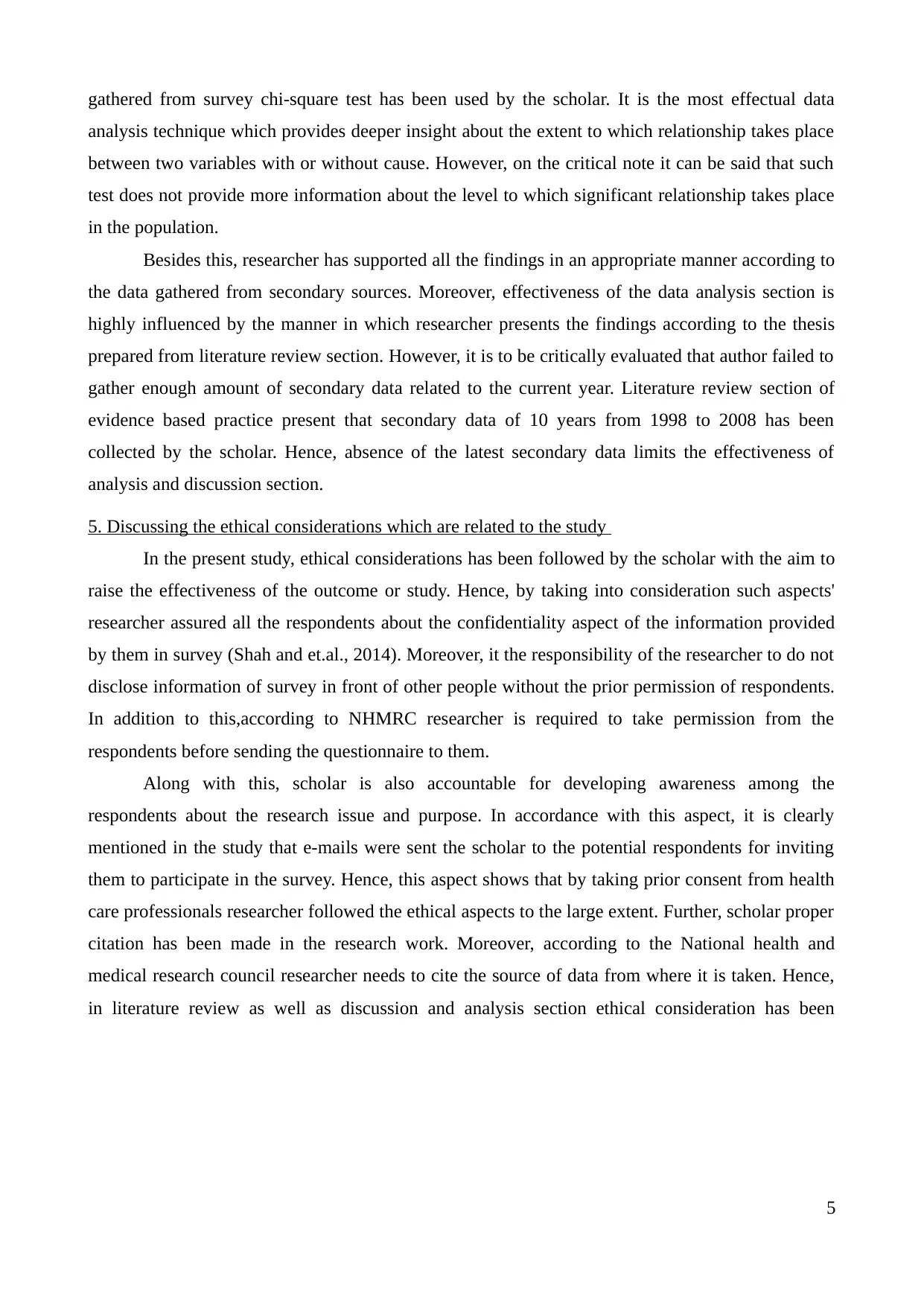
gathered from survey chi-square test has been used by the scholar. It is the most effectual data
analysis technique which provides deeper insight about the extent to which relationship takes place
between two variables with or without cause. However, on the critical note it can be said that such
test does not provide more information about the level to which significant relationship takes place
in the population.
Besides this, researcher has supported all the findings in an appropriate manner according to
the data gathered from secondary sources. Moreover, effectiveness of the data analysis section is
highly influenced by the manner in which researcher presents the findings according to the thesis
prepared from literature review section. However, it is to be critically evaluated that author failed to
gather enough amount of secondary data related to the current year. Literature review section of
evidence based practice present that secondary data of 10 years from 1998 to 2008 has been
collected by the scholar. Hence, absence of the latest secondary data limits the effectiveness of
analysis and discussion section.
5. Discussing the ethical considerations which are related to the study
In the present study, ethical considerations has been followed by the scholar with the aim to
raise the effectiveness of the outcome or study. Hence, by taking into consideration such aspects'
researcher assured all the respondents about the confidentiality aspect of the information provided
by them in survey (Shah and et.al., 2014). Moreover, it the responsibility of the researcher to do not
disclose information of survey in front of other people without the prior permission of respondents.
In addition to this,according to NHMRC researcher is required to take permission from the
respondents before sending the questionnaire to them.
Along with this, scholar is also accountable for developing awareness among the
respondents about the research issue and purpose. In accordance with this aspect, it is clearly
mentioned in the study that e-mails were sent the scholar to the potential respondents for inviting
them to participate in the survey. Hence, this aspect shows that by taking prior consent from health
care professionals researcher followed the ethical aspects to the large extent. Further, scholar proper
citation has been made in the research work. Moreover, according to the National health and
medical research council researcher needs to cite the source of data from where it is taken. Hence,
in literature review as well as discussion and analysis section ethical consideration has been
5
analysis technique which provides deeper insight about the extent to which relationship takes place
between two variables with or without cause. However, on the critical note it can be said that such
test does not provide more information about the level to which significant relationship takes place
in the population.
Besides this, researcher has supported all the findings in an appropriate manner according to
the data gathered from secondary sources. Moreover, effectiveness of the data analysis section is
highly influenced by the manner in which researcher presents the findings according to the thesis
prepared from literature review section. However, it is to be critically evaluated that author failed to
gather enough amount of secondary data related to the current year. Literature review section of
evidence based practice present that secondary data of 10 years from 1998 to 2008 has been
collected by the scholar. Hence, absence of the latest secondary data limits the effectiveness of
analysis and discussion section.
5. Discussing the ethical considerations which are related to the study
In the present study, ethical considerations has been followed by the scholar with the aim to
raise the effectiveness of the outcome or study. Hence, by taking into consideration such aspects'
researcher assured all the respondents about the confidentiality aspect of the information provided
by them in survey (Shah and et.al., 2014). Moreover, it the responsibility of the researcher to do not
disclose information of survey in front of other people without the prior permission of respondents.
In addition to this,according to NHMRC researcher is required to take permission from the
respondents before sending the questionnaire to them.
Along with this, scholar is also accountable for developing awareness among the
respondents about the research issue and purpose. In accordance with this aspect, it is clearly
mentioned in the study that e-mails were sent the scholar to the potential respondents for inviting
them to participate in the survey. Hence, this aspect shows that by taking prior consent from health
care professionals researcher followed the ethical aspects to the large extent. Further, scholar proper
citation has been made in the research work. Moreover, according to the National health and
medical research council researcher needs to cite the source of data from where it is taken. Hence,
in literature review as well as discussion and analysis section ethical consideration has been
5
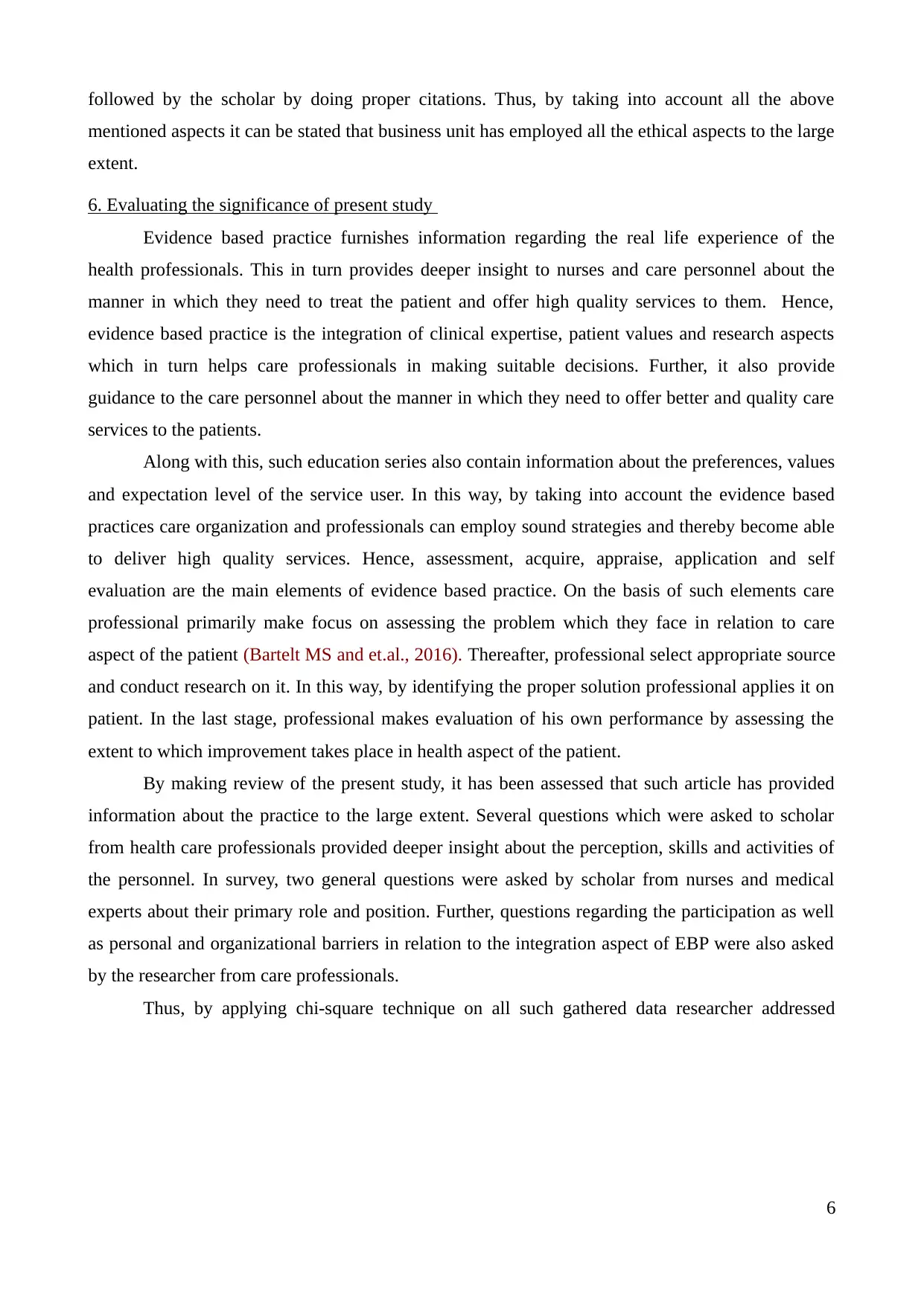
followed by the scholar by doing proper citations. Thus, by taking into account all the above
mentioned aspects it can be stated that business unit has employed all the ethical aspects to the large
extent.
6. Evaluating the significance of present study
Evidence based practice furnishes information regarding the real life experience of the
health professionals. This in turn provides deeper insight to nurses and care personnel about the
manner in which they need to treat the patient and offer high quality services to them. Hence,
evidence based practice is the integration of clinical expertise, patient values and research aspects
which in turn helps care professionals in making suitable decisions. Further, it also provide
guidance to the care personnel about the manner in which they need to offer better and quality care
services to the patients.
Along with this, such education series also contain information about the preferences, values
and expectation level of the service user. In this way, by taking into account the evidence based
practices care organization and professionals can employ sound strategies and thereby become able
to deliver high quality services. Hence, assessment, acquire, appraise, application and self
evaluation are the main elements of evidence based practice. On the basis of such elements care
professional primarily make focus on assessing the problem which they face in relation to care
aspect of the patient (Bartelt MS and et.al., 2016). Thereafter, professional select appropriate source
and conduct research on it. In this way, by identifying the proper solution professional applies it on
patient. In the last stage, professional makes evaluation of his own performance by assessing the
extent to which improvement takes place in health aspect of the patient.
By making review of the present study, it has been assessed that such article has provided
information about the practice to the large extent. Several questions which were asked to scholar
from health care professionals provided deeper insight about the perception, skills and activities of
the personnel. In survey, two general questions were asked by scholar from nurses and medical
experts about their primary role and position. Further, questions regarding the participation as well
as personal and organizational barriers in relation to the integration aspect of EBP were also asked
by the researcher from care professionals.
Thus, by applying chi-square technique on all such gathered data researcher addressed
6
mentioned aspects it can be stated that business unit has employed all the ethical aspects to the large
extent.
6. Evaluating the significance of present study
Evidence based practice furnishes information regarding the real life experience of the
health professionals. This in turn provides deeper insight to nurses and care personnel about the
manner in which they need to treat the patient and offer high quality services to them. Hence,
evidence based practice is the integration of clinical expertise, patient values and research aspects
which in turn helps care professionals in making suitable decisions. Further, it also provide
guidance to the care personnel about the manner in which they need to offer better and quality care
services to the patients.
Along with this, such education series also contain information about the preferences, values
and expectation level of the service user. In this way, by taking into account the evidence based
practices care organization and professionals can employ sound strategies and thereby become able
to deliver high quality services. Hence, assessment, acquire, appraise, application and self
evaluation are the main elements of evidence based practice. On the basis of such elements care
professional primarily make focus on assessing the problem which they face in relation to care
aspect of the patient (Bartelt MS and et.al., 2016). Thereafter, professional select appropriate source
and conduct research on it. In this way, by identifying the proper solution professional applies it on
patient. In the last stage, professional makes evaluation of his own performance by assessing the
extent to which improvement takes place in health aspect of the patient.
By making review of the present study, it has been assessed that such article has provided
information about the practice to the large extent. Several questions which were asked to scholar
from health care professionals provided deeper insight about the perception, skills and activities of
the personnel. In survey, two general questions were asked by scholar from nurses and medical
experts about their primary role and position. Further, questions regarding the participation as well
as personal and organizational barriers in relation to the integration aspect of EBP were also asked
by the researcher from care professionals.
Thus, by applying chi-square technique on all such gathered data researcher addressed
6
⊘ This is a preview!⊘
Do you want full access?
Subscribe today to unlock all pages.

Trusted by 1+ million students worldwide
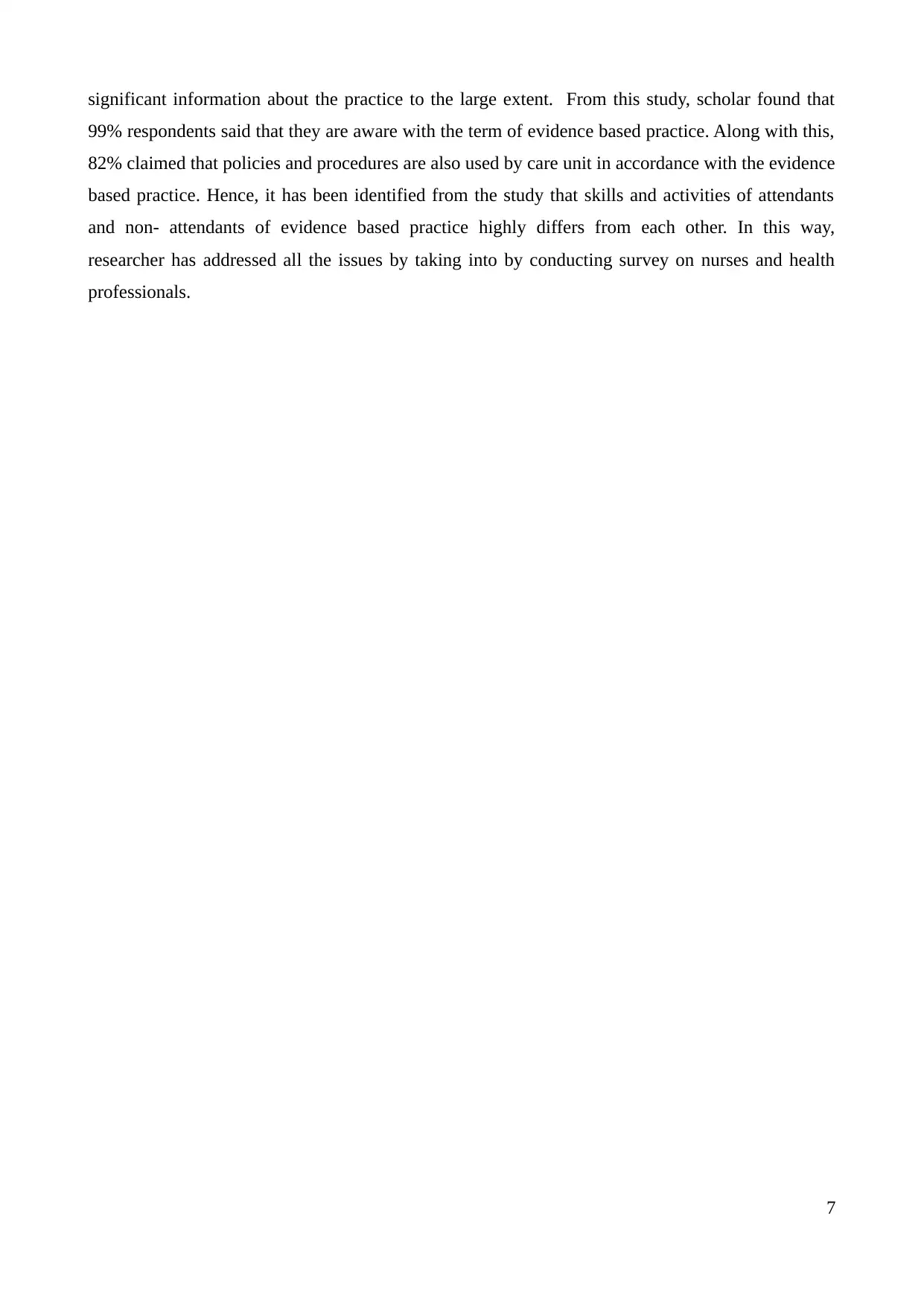
significant information about the practice to the large extent. From this study, scholar found that
99% respondents said that they are aware with the term of evidence based practice. Along with this,
82% claimed that policies and procedures are also used by care unit in accordance with the evidence
based practice. Hence, it has been identified from the study that skills and activities of attendants
and non- attendants of evidence based practice highly differs from each other. In this way,
researcher has addressed all the issues by taking into by conducting survey on nurses and health
professionals.
7
99% respondents said that they are aware with the term of evidence based practice. Along with this,
82% claimed that policies and procedures are also used by care unit in accordance with the evidence
based practice. Hence, it has been identified from the study that skills and activities of attendants
and non- attendants of evidence based practice highly differs from each other. In this way,
researcher has addressed all the issues by taking into by conducting survey on nurses and health
professionals.
7
Paraphrase This Document
Need a fresh take? Get an instant paraphrase of this document with our AI Paraphraser
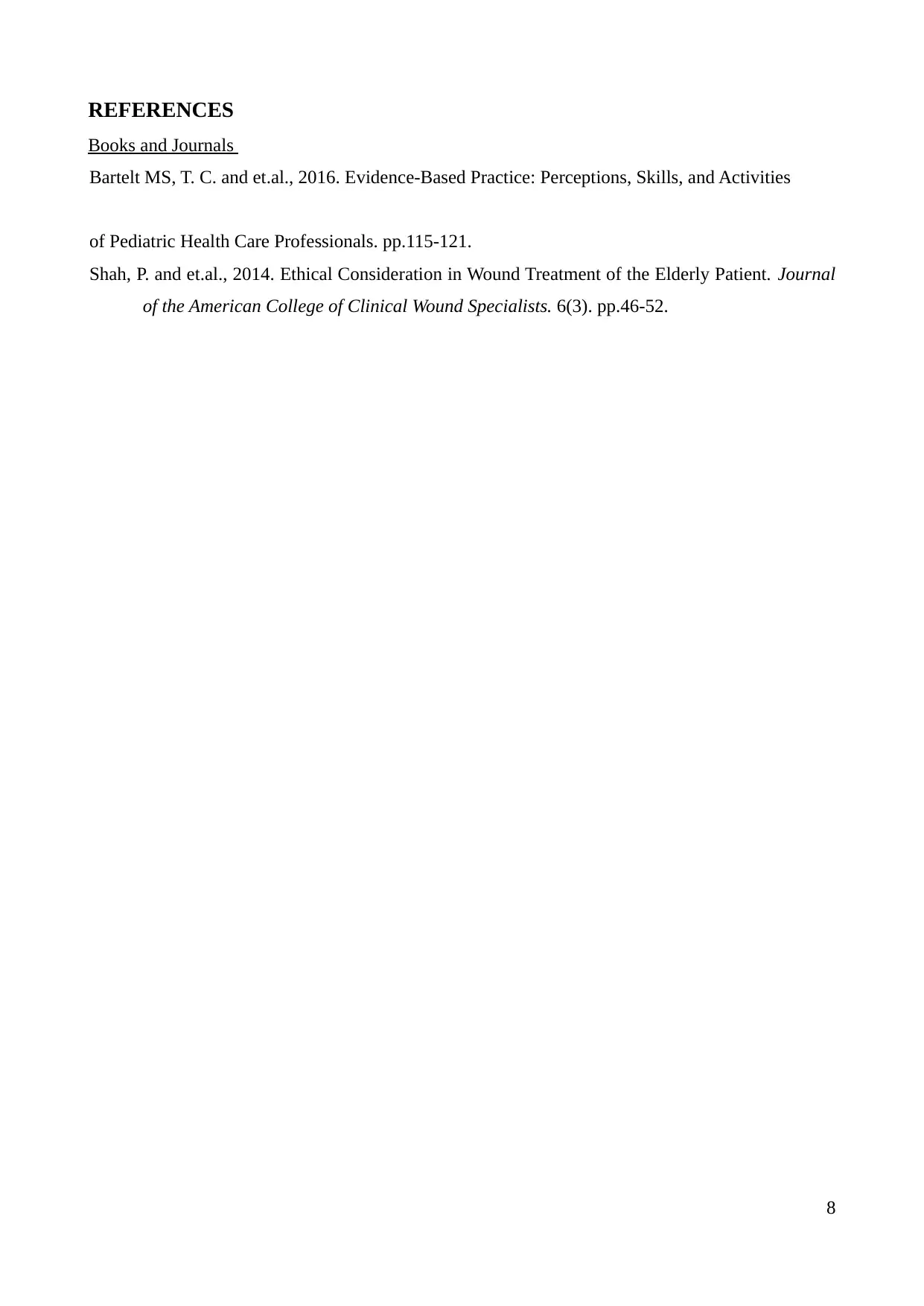
REFERENCES
Books and Journals
Bartelt MS, T. C. and et.al., 2016. Evidence-Based Practice: Perceptions, Skills, and Activities
of Pediatric Health Care Professionals. pp.115-121.
Shah, P. and et.al., 2014. Ethical Consideration in Wound Treatment of the Elderly Patient. Journal
of the American College of Clinical Wound Specialists. 6(3). pp.46-52.
8
Books and Journals
Bartelt MS, T. C. and et.al., 2016. Evidence-Based Practice: Perceptions, Skills, and Activities
of Pediatric Health Care Professionals. pp.115-121.
Shah, P. and et.al., 2014. Ethical Consideration in Wound Treatment of the Elderly Patient. Journal
of the American College of Clinical Wound Specialists. 6(3). pp.46-52.
8
1 out of 8
Related Documents
Your All-in-One AI-Powered Toolkit for Academic Success.
+13062052269
info@desklib.com
Available 24*7 on WhatsApp / Email
![[object Object]](/_next/static/media/star-bottom.7253800d.svg)
Unlock your academic potential
Copyright © 2020–2025 A2Z Services. All Rights Reserved. Developed and managed by ZUCOL.





